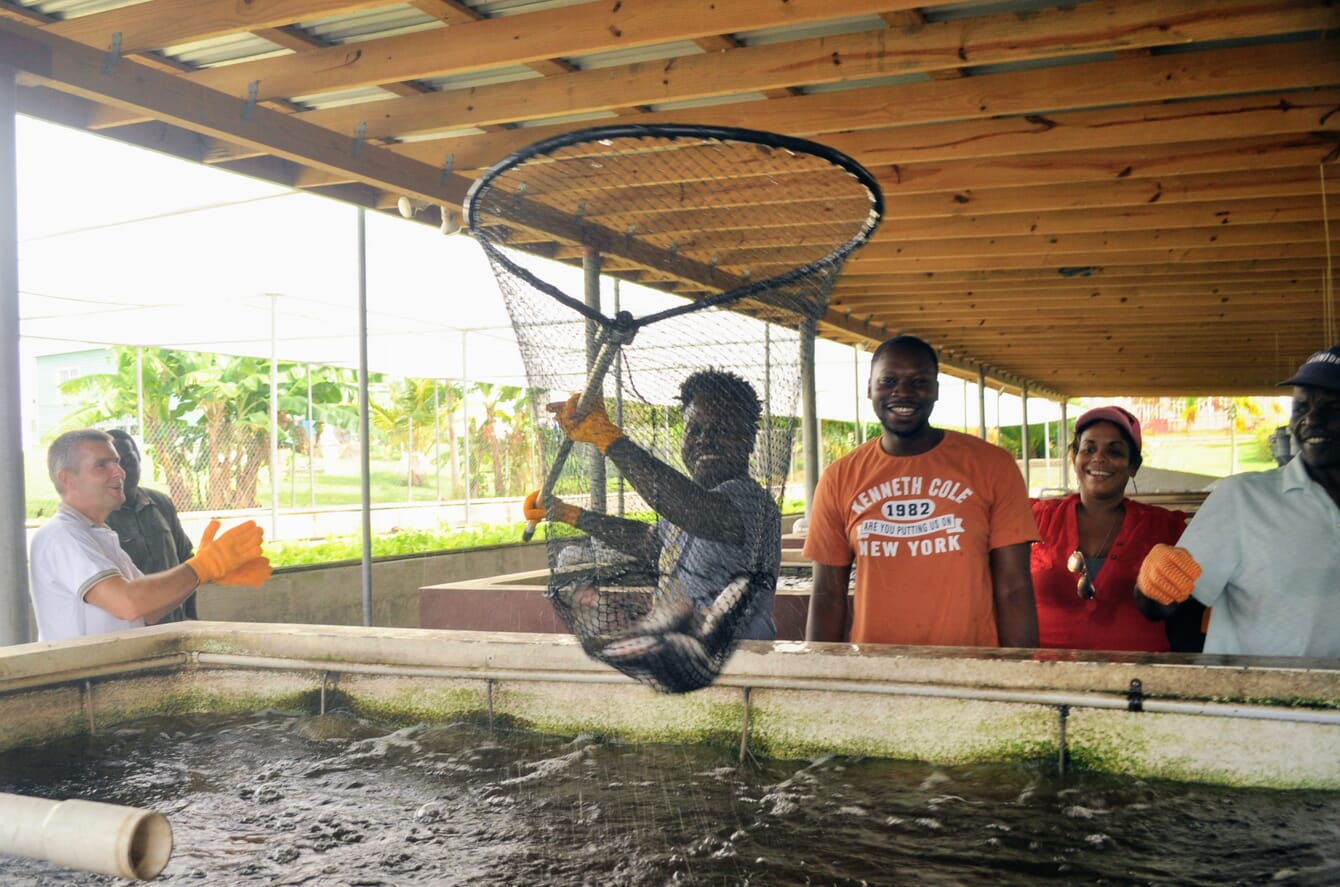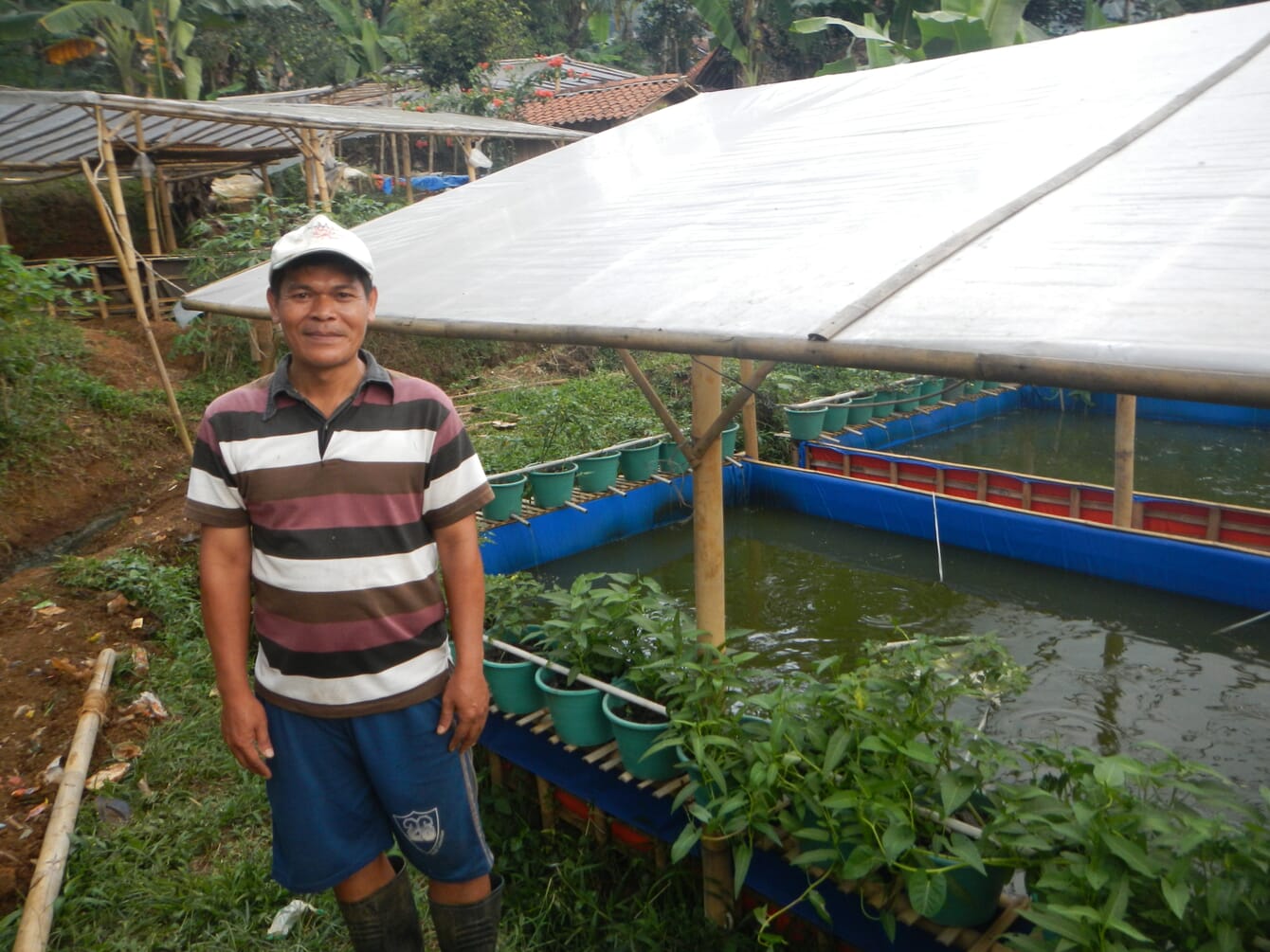
© Austin Stankus
When someone asks me about aquaponics, I always ask them: Why aquaponics? What is your goal? For, without knowing the objective, one cannot measure success. One’s goals could be using aquaponics as a hobby, or for creating a backyard garden of fresh herbs for home use. Many schools look towards aquaponics to complement lectures and lessons on biology, botany, chemistry or physics, or to illustrate food systems and ecology. But, more often than not, the goal is to make money, using aquaponics as the basis of a profitable business.
Each purpose is associated with different levels of risk, investment and operating modes. We should judge the success of an aquaponic intervention against its stated purpose, with a corollary that one of the easiest ways to fail is to not understand the purpose during project design. To demonstrate the diversity of purposes, consider this example. Providencia is a small Colombian island about 250 km off the coast of Nicaragua. When the fishing community lost access to their fishing grounds, aquaponics was investigated as an alternative livelihood for out-of-work fishers.
After a training course, one restaurant owner, Mauricio, adopted aquaponics for a unique purpose and built a small system at his restaurant. He designed the system not to sell vegetables, nor to sell fish. Rather aquaponics has allowed him to become the only restaurant on the island with fresh herbs, for fresh herbs and vegetables are almost impossible to find in Providencia, where all vegetables must be shipped from the mainland on a two-week ferry voyage. Now provisioned with aquaponic-produced herbs, when Mauricio serves a bowl of his signature fish soup he lavishly snips fresh chives and fresh cilantro overtop. The purpose of his aquaponic system was to build business for the restaurant, and his success is not measured on the sale price of cilantro, but in the increased number of customers.
Expanding on this example, aquaponics can be a tool to increase dietary diversity by improving access to and availability of affordable herbs and vegetables, as aquaponics can provide a means to grow a greater variety of foods in places not otherwise possible. This could be an important use for aquaponics in places where fresh vegetables are not available, such as Small Island Developing States, isolated communities in the desert, or even as part of school feeding programmes.
In another example, the Cape Eleuthera Institute in the Bahamas has a particular purpose for their aquaponic system. Their mandate requires efforts to increase the sustainability of their school, and given the isolated nature of their location, this can prove to be quite difficult. To feed their students and staff, they calculate food miles and associated carbon footprint, essentially evaluating the triple bottom line costs from cradle-to-grave. Aquaponics therefore greatly reduces their carbon footprint, by providing kilometer-zero production of fish and salad. Photovoltaic panels power the system, and they offset feed costs (and associated food miles) with locally produced feed (black soldier fly and moringa leaves).
These examples show how aquaponics can be considered successful when they are not “making money”, but what about examples where the purpose is profit?

© Austin Stankus
To quote John Hambrey (2013): “There are a lot of people out there spouting nonsense about fortunes to be made from aquaponics”. To be sure, there are more than enough articles touting the benefits of aquaponics. But if aquaponics is so great, why is it not more mainstream? Indeed, surveys show that aquaponic production is still quite limited in terms of tonnes of food produced, and very few companies are economically viable (Love, 2015, Turnsek, 2020). From a purely commercial or economic development perspective, the disadvantages of aquaponics can often outweigh the advantages. Integrating recirculating aquaculture with hydroponic plant production increases complexity, compounds risk, compromises system optimisation for either product, and restricts management responses – especially in relation to pests, diseases and water quality. Energy use is relatively high because of the need for both aeration and pumping in most systems. Further questions from a sustainability perspective relate to the use of high quality fish feeds as the nutrient source for systems focused primarily on plant production. Solar or wind driven systems are usually required to make them both economically viable and environmentally sustainable, adding to the capital costs. Aquaponic systems have expensive initial start-up costs compared to soil-production or traditional hydroponics. Finally, it is unlikely that farmers in developing countries can afford to buy or run high-tech, high-cost aquaponics systems that depend on electricity 24/7. In addition, aquaponics requires reliable access to inputs, specifically fish seed and feed, which is challenging in less developed areas.
Despite these constraints, there are many examples where aquaponics is working.
One successful example is from Indonesia, with a rapidly expanding aquaponic sector. A unique version of aquaponics, called Yumina, is a radical innovation compared to more ‘traditional’ aquaponic systems. Yumina employs a refreshingly simple design, using only local materials with minimal cost. The power use is low, and it is resilient to power outages. The design, in brief, is a 1 m3 concrete tank, densely stocked with tilapia or Clarias catfish. A small pump (<60 watt) lifts water into a distribution manifold of PVC pipe bent around into a circle, which rests on top of plant containers (flowerpots). A hole is drilled into the manifold and the water enters each flowerpot, flows down past the roots and out through the exit pipe, and waterfalls directly back into the fish tank. The media in the flowerpots filters solid waste, and after each harvest the pot is removed, and the media rinsed (if gravel) or composted (if organic). This innovative design is supported by a dedicated Government research programme, and connected to an extension and support system for farmers. An awareness campaign has exposed at least 10,000 farmers to the practice, and about 3,000 farmers have adopted it. While there are some technical issues, the farmers, extension workers and university researchers are working together through community-based science to address them.
Consider how the Yumina system directly addresses the blocking issues outlined in the paragraph above: the systems are simple and uncomplicated, with low start-up costs. They are locally designed, using commonly available and cheap materials, and the power consumption is very low. And government supported initiatives target beneficiaries with existing experience in fish and plant farming, in areas where feed and seed are available and there is already demand for the products.
Another case, this time from Jamaica, shows a project that explicitly considers the constraints of access to finance, start-up costs and small-business operations. A US-based NGO designed a project where interested farmers first attend an online course on aquaponics small-business management, followed by an intensive training session. Upon completion of the courses and submission of business plan, each farmer is pre-qualified for an agricultural loan which covers full construction costs and initial operating expenses. A quarter of the collateral to secure this loan is provided by the farmer, while the remainder comes from a guaranteed fund, previously negotiated by the project from a development bank, in collaboration with credit unions and local financial institutions. The farmer and project staff build an aquaponic system according to standard blueprints, which are part of training package. The project also includes partnerships along the value chain, both from the sales side (eg wholesale buyers, hotel associations, restaurants) as well as for the inputs: feed, seed, and photovoltaic supplies. An important consideration is how to balance debt-backed loans to the farmers, which introduces financial risk to small-scale holders, with ensuring adequate "buy-in" and commitment from the farmers. One major benefit is a professionalization and market-oriented approach, with potential for long-term anchorage.
In another story, this time from Antigua, a family business began producing tilapia and lettuce. However, local consumers considered tilapia a low-quality fish. As the fish were not selling well, the company conceived a novel marketing and awareness campaign. They started to invite people to the farm for a fish-fry on Sundays after church. A day out with the family, a plate of fried fish, and a farm tour to see how they are grown. Of course the sales from the fried fish helped, but more importantly was that people came back to buy the fish.
Against this backdrop, FAO has organized several training workshops on aquaponics (links to reports included below), with a focus on livelihood development through sustainable integrated fish farming. In each workshop, we asked for recommendations on how to support the adoption of aquaponics in that country. The recommendations were grouped into research tools and innovation; education, training and communication; empowerment, collaboration and extension; and creating an enabling environment. Much of the information is outlined in FAO’s Technical Manual on Small-scale Aquaponic Production (link) and workshop reports. This manual was produced in direct response to calls for open-access and technically sound information on aquaponics, and has since been translated into Arabic (link) and Chinese (in press) by FAO, and Korean, Portuguese, Spanish and Tamil by stakeholders in those countries.
On the topic of research, projects and designs need to include greenhouse and plant protection technologies. Greenhouses are especially important in desert climates and water-scarce areas, and shade houses are needed in the tropics with high solar intensity. Species selection and characterisation is also important, specifically in helping farmers choose the most important and valuable crops for the local conditions and market. Moreover, treatment practices to deal with issues of pests and diseases that are amenable to both the fish and the plants need to be documented and shared. The development of data management tools would facilitate data collection, storage, analysis and documentation, and already mobile applications have been designed for this purpose. Finally, support is needed to develop planning and modelling tools, with subsequent ground-truthing of these models against real world case studies. Relatedly, as part of the design, risk assessment and mitigation need to be considered. This is especially important in the Caribbean countries with a risk of extreme weather and hurricanes.
On the topic of education, training and communication, one of the most important aspects is to increase the visibility of aquaponics, especially among consumers and customers. Among the key stakeholders in a project are the financial institutions, and they must be informed of the risks and benefits of aquaponics in order to make finance accessible to farmers. For the farmers, it is not enough to provide training “in aquaponics”. Capacity building is needed on all aspects of the production (fish, plants, plumbing), as well as in business management, post-harvest processing, permitting and compliance, and marketing. One of the common themes of the success stories starts with empowering aquaponic champions, supporting them to create demonstration sites and continue to innovate, and share aquaponic practices widely through their communities. These demonstration sites are often situated at a private farm, and through public-private partnership mechanisms, these sites are used for training, data collection and outreach. One method has been to use donor-supported projects to establish or expand aquaponic farms, in exchange for in-kind contributions of training and data provision from the farmers. This addresses a common issue in which farms at government-run sites fall into disrepair when the donor money dries up, whereas a private farmer can continue to reinvest profits. Local demonstration sites also address a common issue in which training is provided by foreign “experts”, who come to a country, give a top-down, brief training and then leave. These do not work as well as if the knowledge is co-created with the farmers themselves in a participatory and collaborative way. One example was an FAO-supported action supporting farmers from Algeria, Egypt and Oman to come together in a series of exchange visits (link). Travelling to more than ten integrated aquaculture and agriculture farms, farmers shared water saving practices and were able to share what works, and what does not, in a local context. This sharing can also be strengthened through the use of modern communication technologies to support technical networking.
Finally, on the topic of enabling environment, there is a need to promote collaboration between the departments of aquaculture and agriculture. Also, to advocate at policy level to include aquaponics within existing legislative frameworks to facilitate licensing and certification. Often aquaponics does not have an institutional home within an organization – and has to be shoe-horned within either aquaculture or agriculture – and the collaboration is often missing.

© Austin Stankus
In summary:
- Key message: know your purpose!
- Identify locations and communities that would benefit most, based on participatory needs assessments.
- Implement awareness campaigns – demonstration systems, agriculture fairs, school systems, cooking competitions – and engage with the tourist sector.
- Adapt best practices and technical guidelines to the local context.
- Develop and document scalable, profitable systems.
- Support farmers in capacity development (South South Cooperation / regional), including basic business skills, financing plans, post-harvest processing and marketing.
- Support value chain development and market leverage for farmers.
- Address supply-side issues: specifically feed, seed and other inputs.
- Empower aquaponic champions and demonstration sites as repositories of technical knowledge, hubs of innovation and spokespersons for aquaponics.
- Harmonize policy across sectors to support an enabling environment, including empowering the transfer of technologies, extension and training within national agriculture development plan.
Aquaponics is not the right practice for all places, and anyone considering investing in commercial aquaponics – from private businesses to governments to development agencies – should be aware of the risks, and explicitly address each risk in the project or business design. But aquaponics is right for some places, offering an innovative and sustainable farming practice with documented success stories and applications for many different purposes.


